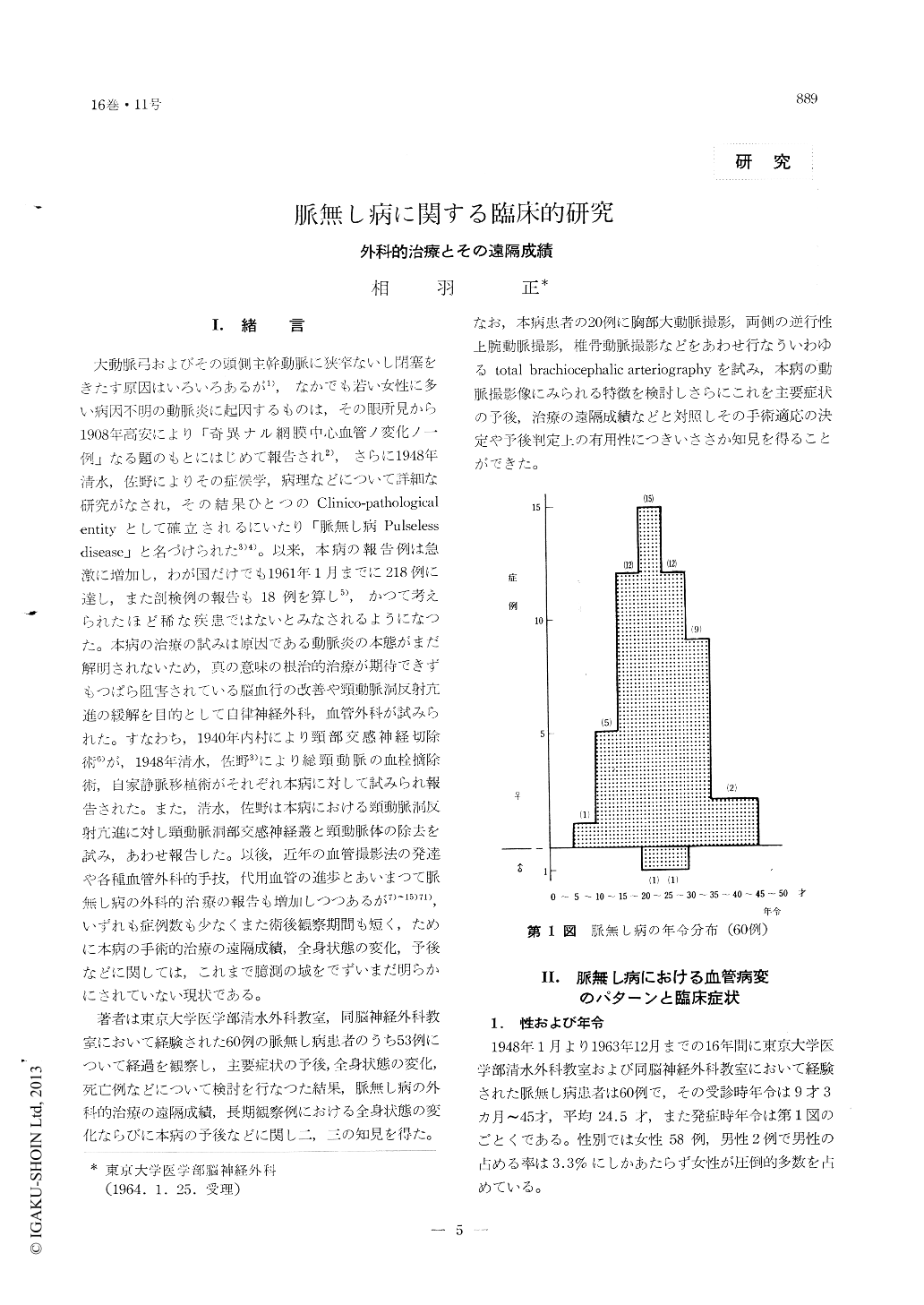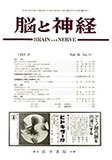Japanese
English
- 有料閲覧
- Abstract 文献概要
- 1ページ目 Look Inside
I.緒言
大動脈弓およびその頭側主幹動脈に狭窄ないし閉塞をきたす原因はいろいろあるが1),なかでも若い女性に多い病因不明の動脈炎に起因するものは,その眼所見から1908年高安により「奇異ナル網膜中心血管ノ変化ノ一例」なる題のもとにはじめて報告され2),さらに1948年清水,佐野によりその症候学,病理などについて詳細な研究がなされ,その結果ひとつのClinico-pathological entityとして確立されるにいたり「脈無し病Pulseless disease」と名づけられた3)4)。以来,本病の報告例は急激に増加し,わが国だけでも1961年1月までに218例に達し,また剖検例の報告も18例を算し5),かつて考えられたほど稀な疾患ではないとみなされるようになつた。本病の治療の試みは原因である動脈炎の本態がまだ解明されないため,真の意味の根治的治療が期待できずもつばら阻害されている脳血行の改善や頸動脈洞反射亢進の緩解を目的として自律神経外科,血管外科が試みられた。すなわち,1940年内村により頸部交感神経切除術6)が,1948年清水,佐野3)により総頸動脈の血栓摘除術,自家静脈移植術がそれぞれ本病に対して試みられ報告された。また,清水,佐野は本病における頸動脈洞反射九進に対し頸動脈洞部交感神経叢と頸動脈体の除去を試み,あわせ報告した。以後,近年の血管撮影法の発達や各種血管外科的手技,代用血管の進歩とあいまつて脈無し病の外科的治療の報告も増加しつつあるが7)〜15)71),いずれも症例数も少なくまた術後観察期間も短く,ために本病の手術的治療の遠隔成績,全身状態の変化,予後などに関しては,これまで臆測の域をでずいまだ明らかにされていない現状である。
著者は東京大学医学部清水外科教室,同脳神経外科教室において経験された60例の脈無し病患者のうち53例について経過を観察し,主要症状の予後,全身状態の変化,死亡例などについて検討を行なつた結果,脈無し病の外科的治療の遠隔成績,長期観察例における全身状態の変化ならびに本病の予後などに関し二,三の知見を得た。なお,本病患者の20例に胸部大動脈撮影,両側の逆行性上腕動脈撮影,椎骨動脈撮影などをあわせ行なういわゆるtotal brachiocephalic arteriographyを試み,本病の動脈撮影像にみられる特徴を検討しさらにこれを主要症状の予後,治療の遠隔成績などと対照しその手術適応の決定や予後判定上の有用性につきいささか知見を得ることができた。
Among various forms of carotid occlusions and aortic arch syndromes, the pulseless dssease is a peculiar entity. Pathology lies essentially in the aortic arch with its branches and the pulmonary arteries. Histologically this is panarteritis with giant cell granulomas. Thrombosis begins in very charac-teristic sites, namely in a portion of both subclavian arteries distal to the vertebral ramification and in the distal part of both common carotid arteries just proximal to the bifurcation.
This disease usually affects young females, 58 out of 60 hospitalized cases being females in this series. The age of onset of symptoms ranges from 8 to 40 years, most predominantly from 11 to 25 years (55 % of the cases). The slow obliteration of main trunks arising from the aortic arch produces a chronic ischemia of the head and upper extremities. This obliteration manifests itself clinically by the follow-ing symptoms and signs: (1) no radial pulsation (100%), (2) symptoms and signs referable to the hyperactive carotid sinus reflex (88%), (3) hypoten-sive ophthalmoangiopathia including hyperemia of the bulbar conjunctiva (70%), new growth and anasto-mosis of the retinal vessels (63%), (4) cerebral symptoms and signs varied from apoplectic at onset to episodic or minor complaints (100%).
In the pulseless disease, arteriography is indicated in all cases and arteriographic visualization of all vessels is necessary because of the high incidence of multiple and diffuse involvement. Total brachioce-Oahe arteriography which consists of aortography via transfemoral route and retrograde brachial arterio-graphy has been performed on more than 20 patients out of the recent cases during the past 2 years. In this study characteristic angiographical pattern of the vascular lesion and collateral pathways not previously known or appreciated in this disease were demon-strated and evaluated.
Various kinds of medication including anticoagul-ants, vasodilatatory drugs and steroids have been tried. In order to relieve carotid sinus syndrome and to re-establish blood supply to the brain, denerva-tion of the carotid sinus (adventitiectomy and removal of the carotid body) and thrombectomy or thromboendoarterectomy were performed. In a few cases, internal-external carotid anastomosis, resection of the carotid and vein or arterial grafts, and bypass graft were tried.
The follow up results of these operations in 2.5 to 15 years are rather poor, as far as the re-establish-ment of the cerebral blood supply is concerned. Good or fair results are obtained in only about one-third of the cases. As for the syncopal attacks, however, bilateral denervation is very effective and all of the cases operated on are relieved from syncopal and vertigo attacks.
Out of 47 operative cases, 30 are still alive, the survival being from 2 years 6 months to 15 years and out of these 30 cases, 26 are spending useful lives. Up to date 12 cases are dead, two of which are operative death. Four out of remaining ten cases died of cerbrovascular insufficiency and the others incidental, (probably) complications such as pulmonary tuberculosis.
These results will be and should be improved with advancement in vascular surgery. There will also be hope for medication therapy, if we can elucidate the pathogenesis and the true nature of the disease.

Copyright © 1964, Igaku-Shoin Ltd. All rights reserved.


